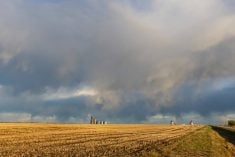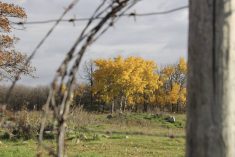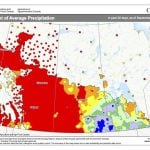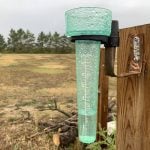Sunshine prevailed a fair bit more over the last forecast period than expected and so did the milder temperatures. Oh, sure there were a couple of cold nights, especially over the eastern half of the prairies, but overall, temperatures ended up being about 2 to 4 C warmer than what was forecasted.
The current weather pattern has an upper trough of low pressure over north Quebec and into eastern Hudson Bay, a weak ridge of high pressure over western Canada, and a second trough of low pressure off the west coast. An area of Arctic high pressure is dropping southeastwards into northwestern Ontario and dipping around the upper trough.
Read Also

Saskatchewan Crop Report: Harvest nears completion
Saskatchewan’s harvest was 98 per cent complete as of Oct. 13 before rain and snow fell onto some regions.
The trough of low pressure is working inland, eroding the upper ridge over western Canada. This will allow for an area of low pressure to move into the Yukon and then track southeastwards across the northern prairies. While this low will not bring much, if any, precipitation to the agricultural prairies, it will break down what remains of the upper ridge. This will let a second low move in off the Pacific late in the weekend and into the early part of next week.
How this low behaves and what the resultant weather will be is still very much in the air. There isn’t a lot of confidence between the weather models or even between individual runs within individual models. The only thing that the models appear confident in is that there will be some kind of low/storm system impacting the central to southern prairies in this time frame.
It looks like the low will move into southern Alberta on Sunday and bring clouds along with measurable snow to western and central regions. This low is forecasted to then track southeastwards, with the main area of low pressure dropping into the northern U.S.
It then looks like the low will track east, then northeast as it moves into Ontario by Tuesday or Wednesday. If this track materializes, then much of southern Saskatchewan and Manitoba could see measurable snow.
Alberta
With weak upper ridging in place, the start of this forecast period looks sunny and mild. Expect daytime highs to be in the 4 to 6 C range with overnight lows falling into the -5 to -10 C range-coldest where there is snow cover.
An area of low pressure is forecasted to move in from the Pacific on Sunday. Expect increasing clouds along with developing snow late on Sunday and on Monday. Exact locations for the snow are a little uncertain. Best indications are for significant snowfalls of up to 20 cm in extreme western regions with 5 to 10 cm over central regions. Southern regions are only forecast to see a dusting near the U.S. border with maybe 2 cm in the Calgary region. As the picture becomes clear I will send out an update.
There will be a brief cooldown behind the low as high pressure drops southwards. Expect daytime highs to be in the -5 C range with overnight lows falling to around -15 C. Expect temperatures to begin warming by the midweek with daytime highs pushing the freezing mark by Wednesday or Thursday over southern and central regions.
Saskatchewan
Like Alberta, this region looks to see nice sunny and mild weather to start off this forecast period as high pressure dominates the region. Expect daytime highs to be the in 3 to 5 C range over southern regions and in the 0 to 3 C range over central areas. Overnight lows are predicted to fall into -6 to -10 C range. These sunny and mild conditions are forecast to last right through to Sunday before an area of low pressure begins to impact the region.
This low is forecast to move on off the Pacific and into southern Alberta on Sunday and then track into Saskatchewan on Monday. As in moves into Saskatchewan, the system will likely drop southward. Before this happens, the weather models show that a significant shield of precipitation will form over Saskatchewan in an arc stretching from southeast regions northwest towards Saskatoon and then on westwards towards Alberta. Current forecasted amounts are calling for upwards of 10 cm over southeastern regions and as much as 10 to 15 cm over south-central areas. Confidence in the placement of this snow is low, so watch for updates.
This system looks fairly progressive and should be out the region by mid-day Tuesday. Arctic high pressure will then drop southwards and bring a couple of day of seasonable temperatures with daytime highs in the -7 to -10 C range and overnight lows falling to around -17 C.
Manitoba
Just like Alberta and Saskatchewan, this region will also see plenty of sunshine and mild temperatures to start off this forecast period. Expect daytime highs to be in the -2 to +2 C range with overnight lows falling to around -12 C. Friday will be the coldest day as an area of high-pressure skirts around the northeast.
By Monday, this region should see increasing clouds as the western low approaches. Current indications are that southern regions could see a quick shot of 2 to 4 cm of snow or possibly some freezing rain as the warm front ahead of the low lifts northwards.
As the low tracks by to the south, it looks like widespread snow will continue across most of southern and south-central regions with weather models predicting around 10 cm over western regions and around 5 cm in the east. Clouds and precipitation associated with the low should be out of the province by late on Tuesday.
Colder arctic air is then forecasted to move in on Wednesday and Thursday, bringing a return of seasonable late winter temperatures. As with both the Alberta and Saskatchewan forecast, confidence in the second half of the forecast is low so watch for updates.

















